Imagine walking into your favorite guitar shop, licking your musical chops at the rows of glossy fretboards and gleaming knobs. Your eyes drift down the line, skimming over the six-stringed exemplars, even the seven-string virtuosos, until they fixate on an alien being. A radically modern instrument that looks like it decided to evolve away from the pack – a headless 8 string guitar. Suddenly, your understanding of guitars, of music itself, shifts dramatically.
Who am I, you ask? My name is Robert Williams, a seasoned guitar journalist who has spent years exploring the vibrant, intricate world of guitars. Naturally drawn to their versatility and profound resonance, today I invite you on a journey into the realm of the headless 8 string guitar, a contemporary marvel that’s redefining established norms.
Mysterious their profile might be, but these headless wonders offer an exciting challenge for the audacious artist. A thrilling blend of profound tuning stability, extended range, unique tonal options, and unmatched neck comfort; be prepared, for they command a new world of exploration.
Buckle up, as we dive into popular models, kits and playthroughs of these headless 8 string guitars, unearthing the moving symphony that echoes from their strings.
Exploring Popular Headless 8 String Guitar Models
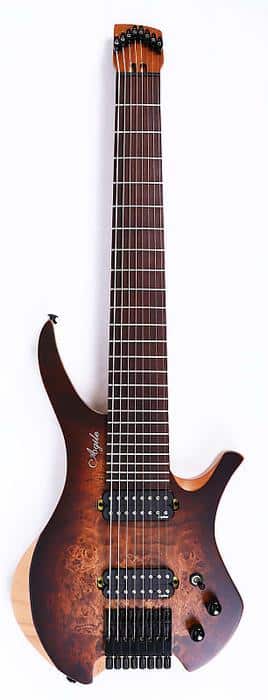
I have spent countless hours exploring headless 8 string guitars, researching their intricate design features, and experiencing, firsthand, the soulful tones they yield. Impressed by the way these guitars align performance with aesthetic appeal, I can confidently say there are a few standout models that deserve due recognition.
Among the myriad of guitar models available, what makes some headless 8 string guitar models stand out from the rest? Allow me to shed some light on this. Three factors come to mind readily; the quality of materials used, the meticulousness in the design, and lastly, the unique tonality they produce.
The Aristides 080s, a leading model in the headless 8 string guitar category, captures these aspects flawlessly. Designed with innovation in its core, this model, made from arium – a special synthetic material, resonates exquisitely, creating a beautiful, balanced, and rich tone that’s incomparable to others. The advantage of arium over traditional tonewoods extends beyond just tonality. It’s incredibly resilient to temperature changes and humidity, providing an extraordinary level of tuning stability.
All Aristides 8 string models, indeed, marinate the new-age build technology with the virtues of traditional craftsmanship, resulting in extraordinary instruments. One striking feature that stands out in these models, met with a significant nod of approval by guitarists worldwide, is the comfortable neck profile. On slipping my fingers along the neck of the Aristides 080s, I experienced a delightful comfort, translating to more extended hours of playing with minimal fatigue.
Another intriguing piece that left a lasting impression on me was the Strandberg Boden OS8. Aesthetically minimalistic, yet its features are anything but. You notice the multiscale fretboard design first – a clever add-on that accommodates the string tension variably, enhancing playability. Moreover, the Endurneck profile, a patented design unique to Strandberg, promotes a more natural hand position – a thoughtful addition to reduce stress on long practice sessions.
Although not as widely recognized, the Kiesel Vader V8 has been gaining momentum amid eight-string enthusiasts. In my hands, this guitar felt incredibly balanced and lightweight – courtesy of its compact shape and careful distributions of mass. It sports a well-crafted ebony fretboard, loved for its quick response and bright tonal characteristics. The Vader V8 is a testament to the fact that headless 8 string guitar design can stray far from convention, yet deliver outstanding results.
These headless 8 string guitar models have rightfully earned their place in the spotlight. Their innovative design is crafted with the player’s comfort in mind yet compromising none on the tonal integrity. As my exploration continues, I am excited about the prospect of what I might discover next in the world of 8 string guitars.
So stay tuned. In the next section, I will guide you through the details of the 8 string guitar kits, giving you an insight into assembling and tweaking your own axe. For those with a DIY knack, this will be an intriguing read.
Guide to 8 String Guitar Kits
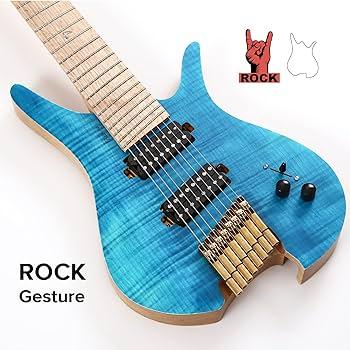
Picture this: The steady rhythm of your heart harmonizes with the anticipation thrumming in your veins as you unpack your first guitar DIY kit. The smooth pieces of wood, untouched hardware, and unassembled components lie before you, a perfect symphony in waiting. You’re not just on the verge of creating sound, but building an instrument capable of symphonies and serenades. That’s the beauty of delving into the world of 8 string guitar kits.
Have you ever fancied building your own 8 string guitar from a DIY kit? My initial encounter with the kit was an adrenaline rush – a priceless experience that cemented my guitar devotion and made me reclaim my fascination with these extraordinary instruments. Trust me when I say, there’s no feeling that compares to the first strum of a guitar you’ve built with your bare hands.
With years immersed in guitar construction and components, I’ll guide you through the thrill-filled journey of an 8 string DIY kit. The process is involved, yet utterly rewarding. It’s about comprehending each component’s role, learning how to assemble them and, finally, attuning the instrument in harmony with your touch. This immersive experience not only moulds you into a finer musician but imbues in you a deeper respect for the instrument.
8 string guitars, as opposed to conventional 6 strings, offer an expanded tonal range. The low B and F# strings are especially appreciated by the metal and jazz communities for their ability to add depth and richness to the sound. Assembling an 8 string guitar from a kit, however, needs extra attention to detail. First, precise installation of the added strings and the extended fretboard is crucial. Second, the double-course strings, more fretted notes, and deeper tones demand additional finesse during installation.
I promise, as daunting as it might seem, the euphoria of playing your own handcrafted 8 string guitar far surpasses any initial apprehension. It’s like a relationship significantly deepened by the depth of your involvement in its creation. Each carefully positioned fret, each string meticulously tuned— they all become nuances of a story intricately woven together by your devotion to music.
Seeing as we’ve now explored the fascinating world of DIY 8 string guitar kits, in the next section we’ll delve into the thrills and nuances of guitar playthroughs. From DIY kits to playthroughs, the journey with 8 string guitars only becomes more exhilarating and rewarding.
Insights on Guitar Playthroughs
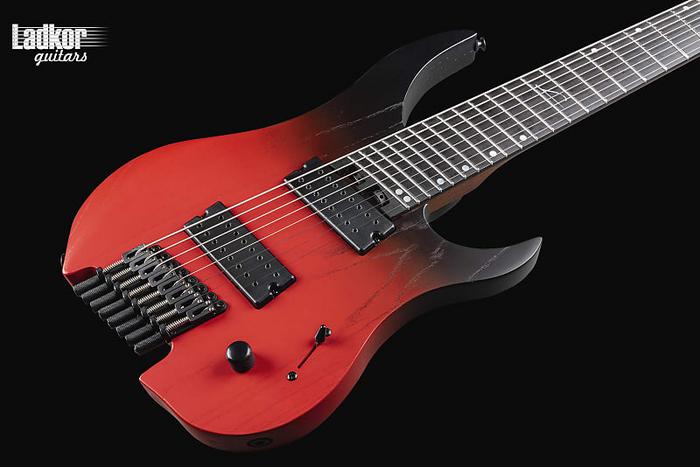
As we unravel the beauty and complexity of headless 8 string guitars, one can’t help but be fascinated by the final, palpable product – the 8 string guitar playthrough. With every note, every pause, and every transition, the playthrough is where the magic truly happens. This section of our journey is crucial because it’s not just about sounding good; it’s about understanding the process, the intricacies that form the foundation of a beautiful playthrough. So, you might be wondering, what’s the secret behind performing flawless 8 string guitar playthroughs?
Being a master’s degree holder in Contemporary Improvisation, I’ve spent countless hours on the stage and behind the scenes, perfecting the art of the 8 string guitar playthrough. I’ve learned a lot along the way. This process is not just about playing the guitar; it’s about comprehending the anatomy of music and interpreting it through this exceptional instrument.
The 8 string guitar playthrough is a delicate balance of synchronisation and skill, understanding the guitar and mastering its mechanics. It’s about sharpening your improvisation skills, and then transcending them to tell a story – your story. The ability not only to reproduce the notes but to make them part of your narrative is what makes a playthrough truly memorable.
From my personal experience, the most rewarding part of learning an 8 string guitar playthrough is the journey itself. Pouring your heart and soul into every practice session, struggling with complex chords, and celebrating small victories along the way, all add up to create a memorable playthrough. However, it’s essential to remember that every musician is unique, and so is every playthrough. A truly flawless performance is one where you bring your art to life, leaving the audience with a memorable musical experience.
Understanding the art of an 8 string guitar playthrough is just like learning a new language – it’s not just about the words, but understanding the context and the sentiment behind them. Similarly, a powerful playthrough is one where you leave a piece of you behind with every note. Emotion, connection, and vulnerability are the ingredients that turn an ordinary playthrough into an extraordinary performance.
This insight is just a glimpse into the world of guitar playthroughs. As we explore the role of fanned frets and multiscale design in the next section, you’ll see how these facets contribute to the overall performance of an 8 string guitar playthrough. Remember, every small detail matters, and these seemingly minor components significantly impact the final output.
The Role of Fanned Frets and Multiscale Design
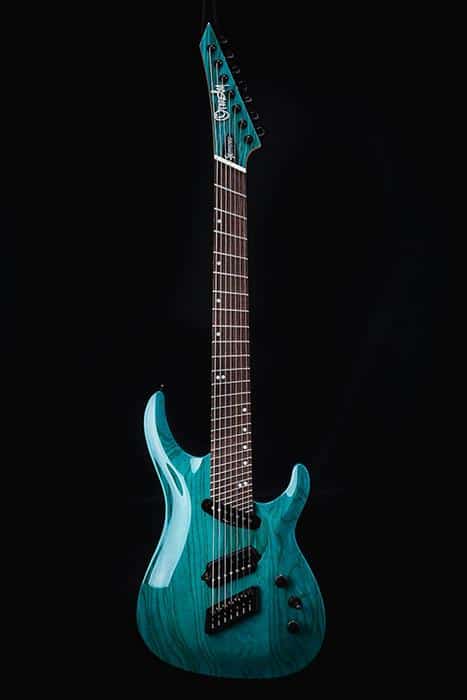
As an experienced and passionate multiscaler, I’ve become intimately acquainted with the wonder of fanned frets and multiscales. Delving into the dynamics of multiscale design is akin to exploring a whole new musical universe. A shift from the traditional, the multiscale electric guitar is an embodiment of a transformative guitar experience building on the premise of offering the player a wealth of tonal possibilities and enhanced playability.
But did you know that the fanned fret and multiscale design are not just stylish but also functional additions to a guitar? It’s more than just an aesthetic distinction; it’s about marrying form to function and expanding your musical sphere. This setup improves intonation and offers a more comfortable hand positioning, making it effortless to play at high speeds or to perform complex chords across the fretboard.
On my own journey as a musician, I was initially attracted by the intriguing look of the fanned fret guitar. However, upon exploring its capabilities, I found it also resonated with the particular string tension and tone quality I wished to achieve. The longer, lower pitch strings offer a richer bottom end, while the higher pitch strings, being shorter, ensure pitch stability.
From a playability standpoint, the slanted frets follow the natural arc of your hand as it moves up and down the neck, making it more intuitive and comfortable. It does take a bit of getting used to, especially after years of playing a ‘normal’ guitar. But I assure you, it’s absolutely worth it.
An 8 string guitar with this characteristic instantly adds uniqueness to your sound and allows for a far more expressive and tactile playing experience. However, this innovative guitar design is not without challenges – some players may find it disconcerting initially and not every style of playing benefits from the fanning fret layout.
This is but one chapter in our exploration of headless 8 string guitars. It’s important to understand these elements and how they contribute to an optimized guitar experience as we continue this journey. Who knows, perhaps the multiscale design will resonate with your playing style and breathe new life into your music as it has with mine.
Understanding Tuning Stability and Neck Comfort
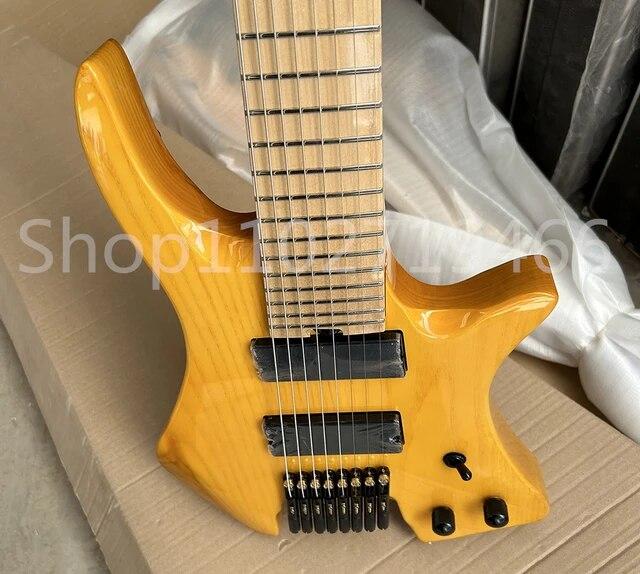
As a seasoned player and enthusiast, I adore exploring various facets of headless 8 string guitars. There’s a unique thrill to traversing the deep resonance of the low strings and channeling the raw, vibrant energy of this versatile instrument. Today, I want to delve into the underrated realm of tuning stability and neck comfort, two essential aspects that go a long way in shaping your extended range guitar experience.
But first, why is neck comfort and tuning stability crucial for mastering extended range guitars like the 8 string guitar? The answer lies in the very mechanics of the instrument. The extra strings, the extended range: they all add layers of complexity in terms of how you play and how the guitar responds. Understanding the nuances of tuning stability and neck comfort will enhance your control and elevate your overall performance.
Let’s start with tuning stability. This essentially refers to the guitar’s ability to hold its tune over time, withstanding environmental changes like temperature and humidity shifts. For an 8 string guitar, stability is even more significant. Maintaining a handle on the wide range without the note going sharp or flat necessitates a robust tuning mechanism. So, while purchasing an 8 string guitar, take the time to inspect the bridge and tuning systems. Explore options with reputable pickups, as they can significantly impact the guitar’s tuning stability and tone quality.
Now, onto neck comfort. With an 8 string guitar, you’re navigating a broader terrain, and neck design plays a pivotal role in ensuring a smooth journey. A well-crafted neck allows for comfortable hand positioning and seamless transitions between notes. It’s not just about the material; the shape, thickness, and the finish of the neck also matter. When it comes to extended range instruments, opt for narrower, flatter necks. Do remember that comfort is subjective. Nothing beats physically trying out instruments to find the one that ‘feels right’.
In conclusion, mastering the 8 string guitar involves more than just technical proficiency. It’s about understanding the instrument, its nuances and complexities, and shaping it to your style. As we move onto our next topic, ‘Perfection in the Details: Fret End Rounding,’ remember that these seemingly minute aspects, like tuning stability and neck comfort, can significantly influence your musical journey.
Perfection in the Details: Fret End Rounding
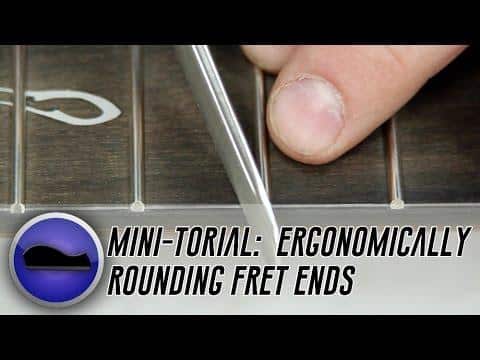
As a meticulous transcriber and engraver, I’ve always believed that it’s the subtle details that separate a good piece from a great one. This principle applies not just to my art but to every facet of life, including the craftsmanship of headless 8-string guitars. What subtle detail on a guitar can significantly upgrade your playing experience? The answer to that lies in fret end rounding.
Firstly, you might ask, what is fret end rounding? In simplest terms, it’s the process of smoothing and rounding off the ends of the frets. A minor change, yes, but one with a significant impact on the playability and comfort of your instrument. As your fingers glide across the fretboard, the delicately rounded ends drastically reduce the chances of scrapes and snags. The result is a fluid, seamless playing experience that lets your creativity flow unfettered.
Fret end rounding is more than just a convenience, it’s a mark of quality craftsmanship. It shows a dedication to perfecting even the smallest details, a commitment to the player’s comfort, and an appreciation for the subtle nuances that enhance a guitar’s performance. Once you’ve played an 8-string guitar with well-rounded fret ends, you’ll truly understand the difference.
So as we continue to explore the world of headless 8-string guitars, remember the impact of these subtle yet critical details. I assure you, perfection truly is in the details. In the realm of guitar craftsmanship, fret end rounding is one such detail that turns a good guitar into a great one.
FAQs
What is a headless 8 string guitar?
Why would someone opt for a headless 8 string guitar?
What are some popular models of headless 8 string guitars?
Can I build my own headless 8 string guitar?
Are there any playthroughs I can watch to see a headless 8 string guitar in action?
Conclusion
In my long journey of exploring and playing this incredible instrument, an inevitable question surfaces – what makes the headless 8 string guitar a game-changer in the world of music? It’s not only about the tonal range this instrument offers, or the fact it’s lighter and more convenient for performers. It’s the new realm of possibilities that comes from mastering these guitars, allowing players to experiment with sounds and styles in a way they’ve never done before.
Truly, my experience with the headless 8 string guitar has been transformative. The evolution in design, particularly the innovative role of fanned frets and the breakthrough of multiscale design, have revolutionized the guitar’s playability. And details like fret end rounding signify a level of perfection one wouldn’t anticipate, but quickly learns to appreciate. Add to that the tuning stability and superior neck comfort, and it’s a complete package.
My hope is that this guide, encapsulating everything from popular models to kit guides and insights on playthroughs, has provided you with a holistic understanding. Remember, it’s not just about the guitar, it’s about the music and emotions they help you express. So, pick up a headless 8 string guitar and let your creativity soar!